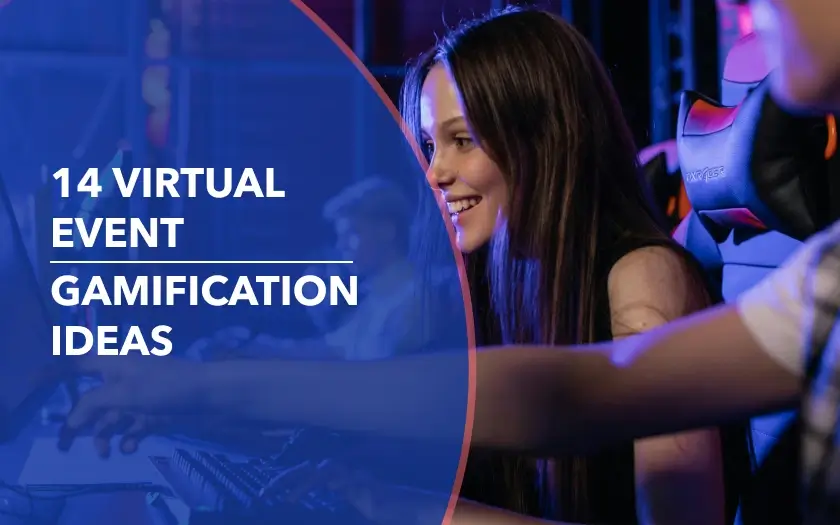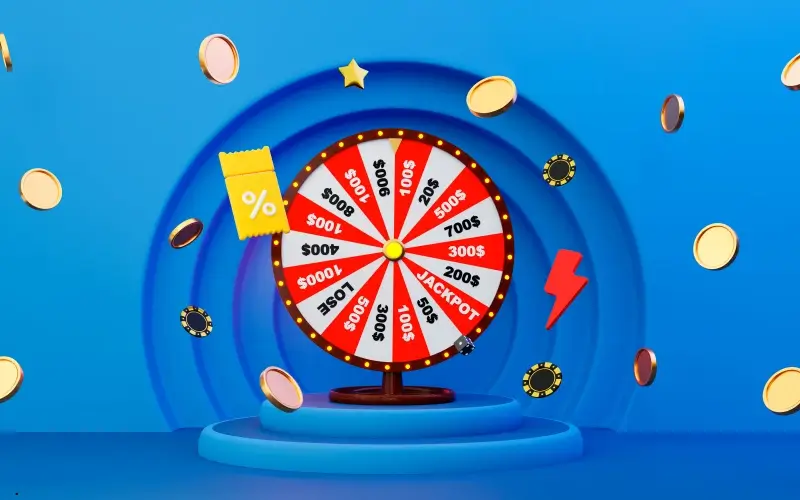14 Virtual Event Gamification Ideas and Examples to Boost Engagement


Games and rewards have always kept people motivated, from classrooms to fitness apps. Think of your Duolingo streak keeping you up at night (“just one more lesson!”), or Starbucks stars convincing you that a third latte in one day is a reasonable life choice. It’s play built into daily life, and it works.
Now, event organizers are tapping into the same approach to keep attendees hooked from the opening keynote to the closing credits. Badges, points, leaderboards, these aren’t just gimmicks; they’re proven mechanics that turn passive audiences into active participants on a virtual event platform.
In virtual events, by giving people things beyond content, you can keep them engaged. It means making the experience fun, interactive, and a little competitive in all the right ways. Virtual event gamification ideas do exactly that, turning attention into action and moments into memories. In this article, we’ll walk you through why gamification matters, how to get it right, and the ideas that can turn your next virtual event into something captivating.
{{table-of-contents}}
What Is Event Gamification?

Event gamification means adding fun, game-like elements to your event to boost participation and engagement. Think challenges, leaderboards, quizzes, or reward points that encourage attendees to explore booths, network, and complete activities. It turns passive participation into active involvement, making the experience more memorable, interactive, and rewarding for both attendees and organizers.
Why Event Gamification Still Matters in Virtual Events

Attention spans at events are shrinking fast. A 45-minute keynote can start feeling like a long traffic jam with no end in sight. Unlike in-person settings, where the energy of the room helps maintain focus, virtual environments compete with dozens of other distractions. This is where gamification provides a structured way to counteract this challenge.
Gamification for virtual events isn’t just about adding bells, whistles, or points for showing up. It’s about re-energizing the virtual event experience so people actually want to engage. Leaderboards, quizzes, scavenger hunts, these aren’t “extras.” They’re the glue that keeps attendees curious, active, and present.
The real impact of gamification extends well beyond entertainment:
- Higher participation: attendees interact instead of zoning out.
- Stronger networking: games lower the awkward barrier to meeting new people.
- Sponsor visibility: branded rewards and challenges drive booth traffic like nothing else.
- Better data: every click, every completed challenge tells organizers what people care about.
Gamification works because it taps into something universal: the need to achieve, compete, and be recognized, whether it’s a digital badge or bragging rights. Virtual event gamification ideas are what keep your experience from being just another tab in the browser.
14 Virtual Event Gamification Ideas & Examples
Successful gamification ideas for virtual events thrive on variety. The best ideas feel natural, easy to join, and give people a reason to stick around. Here are some crowd-pleasers that consistently turn passive audiences into active players.
1. Points, Badges & Leaderboards System

Points, badges, and leaderboards are the peanut butter and jelly of gamification — simple, familiar, and always effective. Award points for attending sessions, visiting sponsor booths, or asking questions in live chat. Stack those points into badges and showcase progress on a leaderboard. Suddenly, attendees aren’t just consuming content; they’re climbing ranks.
Leaderboards add friendly competition (“I can’t believe I dropped from 3rd to 7th!”), while badges deliver quick dopamine that keep people motivated. Just be sure to balance leaderboards with achievable milestones, so everyone feels they can succeed, not only the top players.
For organizers and sponsors, this structure also doubles as a data tool. Points can be tied to priority actions like booth visits or content downloads, ensuring exhibitors see balanced traffic. Keep the design clean, the rewards visible, and the rules easy to follow, and you’ve got an engine of ongoing engagement running in the background of your event.
2. Virtual Scavenger Hunts
Think Pokémon Go, but without leaving your chair. Hide clues or codes across breakout rooms, sponsor pages, or digital posters. For example, attendees might collect letters hidden in session slides that spell out a secret word. Attendees piece them together, unlocking a prize at the end. It’s exploration with purpose, and the thrill of discovery keeps people clicking around.
Scavenger hunts also drive measurable outcomes. They push participants to explore corners of your event they might otherwise miss, such as resource libraries, sponsor booths, or breakout tables. That extra exposure boosts sponsor’s virtual event ROI while giving attendees a reason to engage more deeply with the platform.
Unlike sponsor quests, which are structured to maximize exhibitor traffic, scavenger hunts are attendee-first. They’re designed to make the event feel like a journey rather than a static schedule, turning exploration itself into entertainment.
3. Live Quizzes & Polls
Interactive polls and quizzes keep energy levels consistent across long agendas. When attention starts to drift, a quiz snaps it back. Gamified polls or rapid-fire trivia keep energy high between heavy sessions. Attendees answer in real time, points are tallied, and winners get a prize or spotlight.
The value goes beyond entertainment. In educational contexts, quizzes reinforce learning objectives by helping participants apply new knowledge right away. In brand-focused events, polls double as feedback machines, capturing audience sentiment and guiding live discussions.
Unlike trivia nights, which serve as standalone fun, quizzes and polls are integrated directly into sessions. They’re seamless touchpoints that turn passive listening into active participation, and organizers walk away with insights as valuable as the engagement they generate.
4. Networking Bingo
Structured networking activities reduce the barriers of digital introductions. A virtual bingo format, where attendees seek out participants with specific traits or experiences, creates natural conversation starters and a light-hearted way to connect. Create a bingo card with prompts like “Find someone who speaks three languages” or “Met someone who owns a rescue dog.” Attendees mark off squares as they mingle. You can use ready-made virtual bingo templates from tools like BingoBaker, My Free Bingo Cards, or even Canva to design custom cards in minutes.
This format breaks the ice quickly and gives attendees an easy reason to approach one another. Instead of generic introductions, conversations start with curiosity and fun. The result is not only increased interaction but also a more inclusive networking environment where even less extroverted attendees can engage comfortably.
5. Team Challenges & Group Missions
Not every game needs to be about “me vs. everyone.” Collaboration is as important as competition. Group-based challenges bring attendees together. For example, assign teams a collective mission like solving a themed puzzle, brainstorming ideas, or competing in a hackathon.
These activities strengthen community within the event and provide opportunities for deeper relationship-building beyond surface-level introductions. They also encourage cross-functional networking, as people often work with attendees outside their usual circles. When the team succeeds, every member shares in that win, and that sense of shared achievement is what keeps connections lasting.
6. Spin-the-Wheel Rewards

There’s something timeless about the excitement of chance, whether it’s spinning a digital wheel or waiting for your name in a lucky draw. Bring that thrill online with a digital spin-the-wheel or hybrid lucky draw that rewards attendees for completing event actions, such as attending a keynote, downloading a resource, or visiting exhibitor booths.
The prizes can range from small perks, such as discount codes, coffee vouchers, branded swag, to bigger incentives like free passes for next year’s event, access to a VIP session, or even gift cards. The key is variety: mix a few high-value rewards with plenty of smaller ones so that every spin feels worthwhile.
Beyond engagement, spin-the-wheel mechanics can also be tied strategically to sponsor goals. For instance, an attendee might only unlock a spin after visiting three sponsor booths, ensuring balanced traffic across the exhibitor floor. Or, spins could be triggered at scheduled times during the day, motivating people to log back in for multiple sessions. The beauty of this format lies in its unpredictability. Even a modest prize feels more exciting when won through chance, and that anticipation keeps people coming back for another spin.
7. Trivia Nights & Mini-Games

Long event agenda? Sneak in short bursts of fun. Five-minute trivia rounds or quick mini-games between sessions reset energy levels and prevent “Zoom fatigue.” Carry scores across the event so trivia doesn’t feel isolated: it’s part of the bigger game.
This approach is particularly effective for reinforcing key messages or maintaining energy during multi-day conferences. It’s light and gives attendees something to look forward to between heavier content.
In contrast to session-based quizzes, trivia nights, and mini-games are social breaks that build community and energy across the event.
8. Virtual Escape Rooms
Escape rooms aren’t just for corporate off-sites anymore. In a virtual event, themed virtual escape rooms encourage small-group collaboration through problem-solving. By aligning puzzles with event themes, such as security, sustainability, or innovation, organizers can create experiences that are both entertaining and relevant. Think a cybersecurity summit where attendees “hack the code” to unlock the next level, or a climate conference where teams solve sustainability challenges to escape.
These activities promote teamwork and often lead to stronger interpersonal connections among participants. It’s collaborative, thematic, and surprisingly memorable.
9. Social Media Challenges

Why stop engagement at the event walls? Gamified activities can extend beyond the event platform through social media campaigns. Invite attendees to post selfies, share takeaways, or complete creative prompts on social platforms. Hashtags keep entries trackable, and prizes keep momentum alive.
The ripple effect is huge. These challenges amplify your event’s reach, generate authentic user-generated content, and turn attendees into brand advocates. A selfie station or “share your setup” challenge creates instant buzz across feeds. Recognition is just as important as prizes. Featuring posts in-session or spotlighting winners on social channels motivates more participants to join in. It’s a win for engagement and social media event promotion at the same time.
10. Gamified Networking Lounge
Sometimes, networking can be awkward. Gamified lounges fix that by giving attendees missions like “Join a virtual table and find three people working in your industry.” Or, “Introduce yourself to someone from a different country and swap one fun fact.” Points or badges are awarded for each connection. Success can be measured by tracking completed missions, number of new connections made, or chat engagement within the lounge.
This approach reduces friction in networking and supports meaningful exchanges. Instead of forcing conversations, attendees have a reason to approach one another, which makes the process more natural. Organizers can theme the missions to align with event goals, for example, pairing attendees with complementary skills in a startup conference. Sponsors also benefit when lounge missions include visiting branded tables or engaging in product-focused discussions. The result? More conversations, stronger connections, and a networking environment that feels intentional instead of random.
11. Sponsor Engagement Quests
Sponsors want traffic, attendees want rewards. Gamification can bridge the two and directly support exhibitor and sponsor objectives. Create a digital passport that attendees must “stamp” by visiting multiple booths, downloading resources, or chatting with representatives. Completion can be linked to raffle entry, bonus points, or additional event benefits. It’s simple, sponsor-friendly, and ensures every booth gets attention.
While similar to scavenger hunts, sponsor quests are specifically structured to drive exhibitor ROI and ensure balanced booth traffic. Organizers can even customize stamps with sponsor branding, making the activity itself a marketing touchpoint. The end result is a win–win: attendees enjoy the chase, and sponsors see measurable engagement across the board.
12. Hybrid Gamification (Onsite + Online Tie-Ins)
.webp)
For hybrid events, games that span both physical and digital environments strengthen cohesion across audiences. This ensures that online attendees aren’t left out while onsite participants get the same interactive experience. For example, onsite attendees might scan QR codes around booths to unlock trivia, complete mini challenges, or explore digital sponsor pages, just like their virtual counterparts. Both groups contribute points toward a shared leaderboard or team-based reward. Together, they unlock shared rewards.
By blending the physical and digital, hybrid gamification makes the event feel like one unified experience instead of two parallel ones, creating fairness, inclusion, and excitement for all participants. Tools like RFID badges, event apps, and QR code check-ins can sync onsite and online data, ensuring points and progress are tracked seamlessly across both worlds.
13. Mystery Boxes & Surprise Drops
Everyone loves a surprise. By releasing rewards at unexpected moments, organizers can keep participants alert and engaged throughout the event. These rewards might include access to a VIP session, a gift card, or early-release content, delivered to those who are most active during key times.
The magic is in the unpredictability. Attendees stay tuned in because they don’t want to miss what could happen next, whether that’s a mid-keynote announcement, a pop-up notification in the networking lounge, or a prize drop triggered by engagement milestones. It’s the same psychology that makes people check their phones for notifications: curiosity mixed with reward. Unlike spin-the-wheel, which participants choose to activate, surprise drops are timed strategically by organizers.
14. Post-Event Challenges
The game doesn’t have to end when the livestream does. Post-event challenges extend engagement beyond the closing slide. Attendees can be invited to complete a survey, share a recap on LinkedIn, or watch session recordings, with rewards like bonus points, exclusive content, or early access to the next event.
For organizers, these challenges serve a dual purpose: they provide valuable feedback and maintain visibility long after the event ends. For attendees, they create a sense of continuity and a reason to stay connected with the community. This keeps the event alive in attendees’ minds and sustains engagement long after the livestream ends.
Best Practices for Virtual Event Gamification

Gamification works best when it feels natural, not forced. Done well, it transforms events into playgrounds of discovery and achievement. Done poorly, it feels like homework with points attached. Here are four best practices to design gamified virtual event ideas:
- Keep it Snackable: Nobody logs into a virtual event thinking, “I hope I get a 45-minute side quest.” Games should be quick, intuitive, and easy to join. Think bite-sized challenges like a one-question poll or a scavenger hunt clue tucked into the keynote. If it takes a manual to understand the rules, it’s not gamification — it’s work.
- Align with Goals: Every challenge should push attendees toward something that matters. Want more booth visits? Make that a quest. Need session feedback? Turn it into a quiz. The point isn’t to gamify everything but to gamify the right things.
- Reward Smartly: Recognition drives motivation. Badges, leaderboards, and prize draws are effective, but so are shoutouts from hosts, exclusive access, and even quirky rewards like virtual tacos. The key is to make rewards feel meaningful, not random. When attendees feel like their effort is seen and celebrated, they’ll keep playing.
- Balance “Me” vs. “We”: Competition fuels engagement, but collaboration builds community. Mix solo quests with team-based missions so attendees can feel both the rush of winning and the satisfaction of contributing to a group. Leaderboards get people climbing, but group challenges get them connecting, and that balance keeps the whole experience enjoyable.
Tools & Platforms for Virtual Event Gamification
Even the best gamification ideas need the right tools to pull them off. You wouldn’t play Mario without a controller, and you shouldn’t try to run a virtual scavenger hunt without the right tech. The good news? There’s a growing list of well-established platforms that make gamification easy to integrate.
Here are a few favorites:
- Remo: A virtual networking platform that mimics real-world table dynamics. It allows attendees to move freely throughout an event space, making it a perfect platform to complete missions, participate in activities, and get rewarded.
- Kahoot: A real-time quiz and trivia platform. It’s highly effective for energizing audiences during sessions, reinforcing learning, and creating healthy competition.
- Slido: A platform for polls, Q&A, and live audience interaction. It transforms feedback into engaging touchpoints and ensures participants remain actively involved throughout the event.
These aren’t the only players in the game, but they’re some of the most accessible. The real trick is matching the tool to the mission. If your goal is energizing a crowd, Kahoot delivers. If it’s structured networking, Remo wins. Choose wisely, and your platform becomes part of the fun, rather than just the backdrop.
Measuring Success for Virtual Event Gamification
If gamification is a game, then virtual event metrics are your scoreboard. You can’t level up without tracking progress.
- Start with built-in platform analytics: Most event platforms log session attendance, booth visits, poll participation, and chat activity automatically. Export these reports to see engagement trends over time.
- Layer in tracking tools: Use UTM links for sponsor content, QR codes for scavenger hunts, or RFID badges at hybrid events to capture actions with precision.
- Monitor networking behaviour: Track how often people switch tables or rooms by using heat maps in the platform dashboard or by setting event rules that record completed missions.
- Combine with surveys for the “why”: Post-event surveys complement raw data with feedback. Ask attendees which challenges felt fun, which rewards motivated them, and which mechanics they’d skip next time.
- Translate data into improvements: Feed these insights back into your design—tweak point values, adjust badge criteria, or simplify rules where drop-offs occurred.
The more you measure and apply, the smarter your next event becomes. Data proves engagement worked and it helps you fine-tune systems and design experiences that feel sharper every round.
Future Trends in Gamification in Virtual Events

Gamification in virtual and hybrid events is entering a new phase. The focus is shifting from isolated features toward fully integrated experiences that enhance both participation and memorability. Emerging technologies such as AR, AI, and VR are opening new possibilities for engagement.
In practice, this could mean augmented reality scavenger hunts guiding participants through hybrid venues, AI quizmasters that adapt to attendee behavior in real time, or virtual sponsor booths where products can be explored in immersive environments. These innovations represent a movement toward gamification as a central element of event design rather than a supplementary feature.
Looking forward, organizers will increasingly use gamification to personalize experiences, connect audiences across formats, and deliver rewards that feel meaningful beyond the event itself. The result will be events that participants experience actively, rather than passively.
Future gamification trends to watch:
- AR scavenger hunts: Augmented reality will guide attendees through venues or digital maps, blending exploration with discovery missions that link to sponsors or content; that’s how AR is used in events.
- AI-powered quizmasters: Quizzes and challenges that adapt difficulty and tone in real time, making every interaction feel tailored and more engaging.
- VR sponsor booths: VR for events create immersive spaces where attendees can interact with products, demos, or brand activations as if they were physically there.
- Hyper-personalized challenges: AI customizes missions based on attendee role, skill level, or interests, turning one-size-fits-all games into personal journeys.
- Cross-platform play: Hybrid attendees (onsite and online) complete shared missions, ensuring both audiences contribute to the same leaderboard or team goal.
- Reward innovations: Moving beyond gift cards to experiences like VIP meetups, NFTs, or exclusive content drops that extend value after the event ends.
Winning Moves for Virtual Event Gamification
Gamification has moved beyond buzzword status and it’s now a proven strategy to keep audiences engaged, energized, and coming back for more. From badges and leaderboards to immersive challenges and post-event insights, the right mix of fun and functionality can transform any event from “just another webinar” into an experience people remember.
And the best part? You don’t need to reinvent the wheel to get started. Platforms like Remo make it easy to bring gamification to life, with immersive floor plans, features like virtual tables, polls and quizzes and much more. Remo turns networking into an adventure.
So the next time you plan an event, don’t just aim to inform, make it a game. Book a demo with Remo, and see how hosting engaging, memorable experiences has never been easier.
Frequently Asked Questions about Virtual Event Gamification Ideas
1. How much extra work is required to gamify a virtual event?
Gamification doesn’t always need to be huge. Simple things like polls, quizzes, rewards for booth visits, or leaderboards can be added with modest effort. More complex features (custom games, escape rooms, full mission systems) will take more planning and tech.
2. How do you measure the ROI of virtual event gamification?
You can track both quantitative metrics (attendance, clicks, participation in games / challenges, booth visits, downloads) and qualitative feedback (surveys, attendee satisfaction). Platforms with built-in analytics, like Remo, help.
3. Is gamification relevant only for certain types of events or industries (like training or education)?
No. It’s useful across webinars, trade shows, nonprofit events, corporate conferences, product launches. The mechanics may differ, but game elements work in many settings.
4. What are key pitfalls or things to watch out for when using gamification?
Don’t overcomplicate rules and confuse attendees. Don’t focus too much on competition, which can alienate some people. Include rewards that are motivating and don’t ignore measurement and feedback so you always know what’s working.







.webp)




















